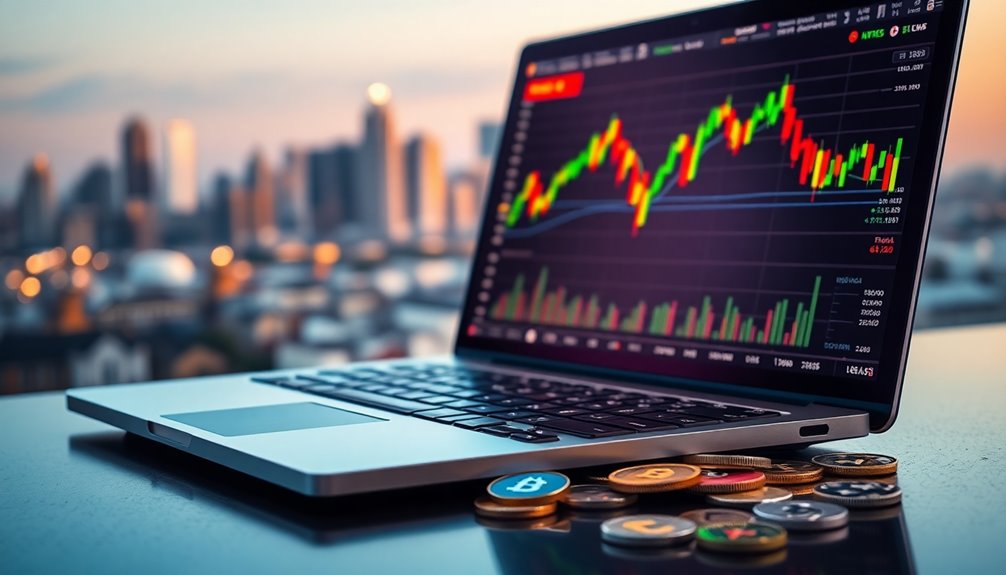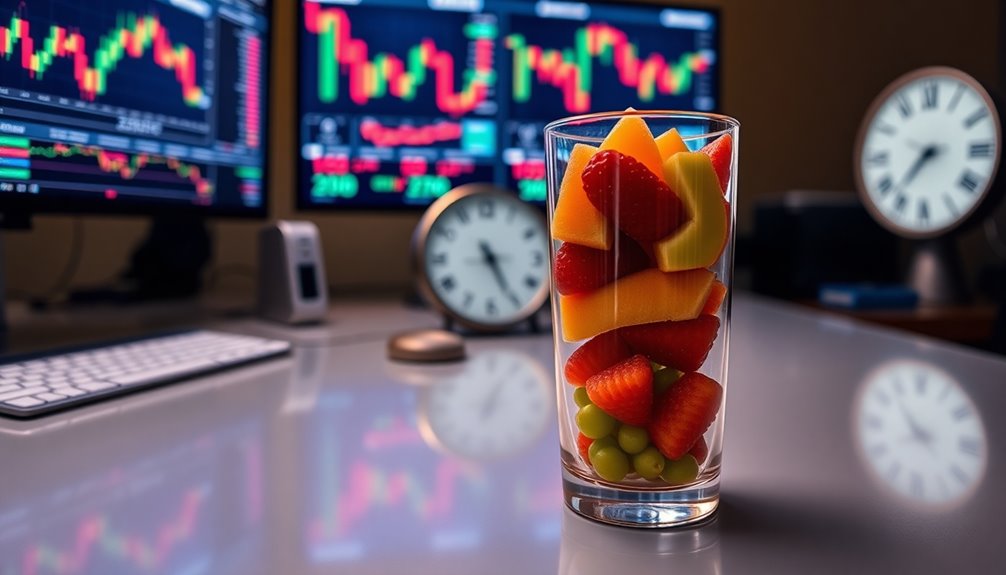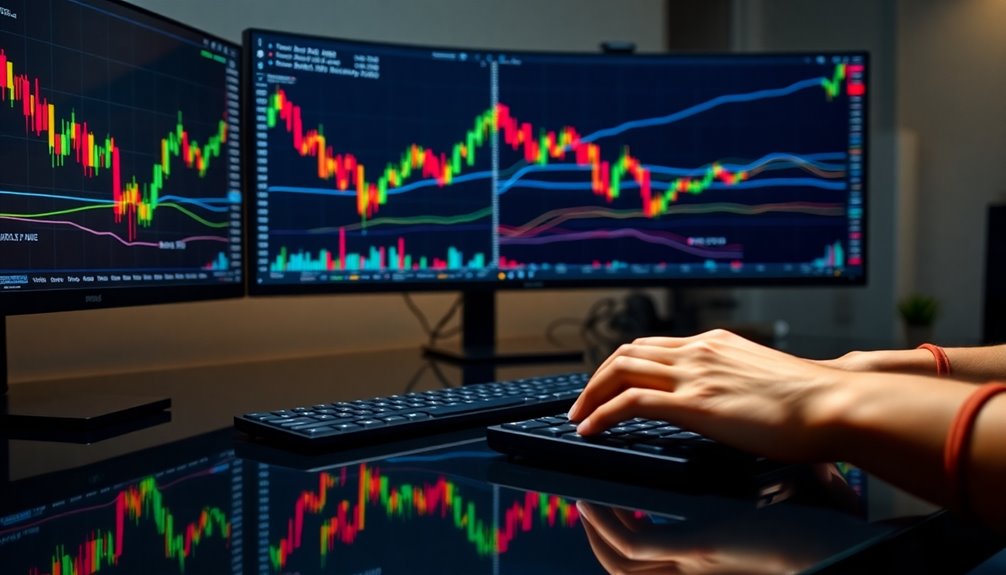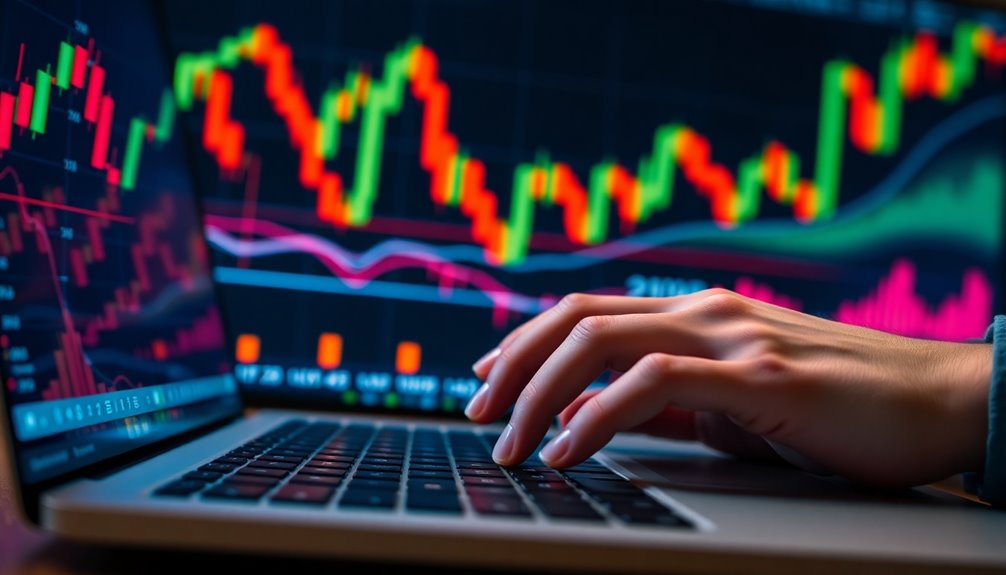Understanding cryptocurrency trading volume is crucial for you as a trader. It reflects the total amount of an asset traded over a specific period, usually 24 hours. High trading volume shows strong market interest and liquidity, often leading to significant price movements. Conversely, low volume can indicate market stagnation or potential volatility. Keeping an eye on volume trends helps you gauge market sentiment and anticipate price fluctuations. For instance, consistent volume increases with rising prices can signal bullish trends. If you want to uncover more insights about navigating these dynamics, there's plenty more to explore.
Key Takeaways
- Trading volume indicates the total amount of cryptocurrency traded, reflecting market liquidity and investor interest over a defined period.
- High trading volume often leads to significant price movements, signaling strong market sentiment and potential bullish trends.
- Sudden spikes in volume can suggest shifts in market sentiment, potential manipulation, or upcoming price changes.
- Volume analysis techniques, like VWAP and Money Flow Index, help traders assess market momentum and identify overbought or oversold conditions.
- Understanding volume dynamics is crucial for making informed trading decisions and navigating the cryptocurrency market effectively.
Volume Measurement in Crypto Trading

When you're diving into cryptocurrency trading, understanding volume measurement is crucial.
Cryptocurrency trading volume reflects the total quantity of a specific asset traded over a defined period, usually in 24-hour intervals. Accurate volume measurement encompasses all executed trades and is essential for assessing market liquidity and investor interest.
By analyzing trading volume, you can gauge overall market sentiment and asset value. Utilize volume indicators like Average Daily Volume (ADV) and Volume Weighted Average Price (VWAP) to enhance your trading strategies.
High trading volume often signals significant price movements, indicating strong market interest, while low trading volume may reveal stagnation.
Mastering these concepts will empower you to make informed decisions during your trading journey.
Market Behavior Insights Revealed

Understanding trading volume not only sharpens your insights into market dynamics but also reveals key behavioral patterns of traders. High trading volume often indicates strong market interest, leading to significant price movements in the crypto market.
When you see sudden spikes in trading volume without clear news, it might signal shifts in market sentiment or even manipulation. Monitoring relative volume compared to historical averages helps you gauge market strength; for instance, a relative volume above 1 suggests potential breakouts.
Additionally, a consistent increase in trading volume alongside rising prices confirms bullish trends, while declining volume during price increases could hint at a price reversal.
Volume Influences Price Fluctuations

As trading volume increases, you'll often see a corresponding rise in cryptocurrency prices, driven by the heightened demand from investors. This surge in buying volume typically signals strong market sentiment, leading to potential price fluctuations and breakouts.
High trading activity generally indicates genuine interest, making price movements more reliable. On the flip side, if prices rise while volume declines, it could suggest market exhaustion, hinting at possible corrections.
Additionally, sudden spikes in trading volume without clear reasons may indicate manipulation, which can destabilize prices and shake investor confidence. Understanding these dynamics helps you navigate the market more effectively, enabling you to make informed decisions based on trading volume and its influence on price trends.
Pros and Cons of Volume

High trading volume offers both advantages and drawbacks that every trader should consider.
On the positive side, high volume typically indicates strong market sentiment and liquidity, enabling smoother trade execution and lower transaction costs. It can also confirm price trends, with upward movements often signaling bullish momentum.
However, low trading volume may suggest weak interest, leading to volatility and challenges in executing trades at desired prices. Additionally, volume spikes can hint at potential market manipulation, requiring careful analysis to avoid falling for false signals.
Understanding these dynamics is crucial for informed trading, as they directly influence price movements and overbought or oversold conditions, ultimately affecting your overall trading strategy.
Volume Versus Price Correlation

While trading volume can often provide insights into price movements, it's essential to analyze their correlation carefully.
In the cryptocurrency market, higher trading volume can indicate strong demand, often leading to an increase in the price of a cryptocurrency. For example, Bitcoin's price surge in early 2021 coincided with a significant spike in trading volume.
Conversely, declining prices coupled with rising volume may signal bearish sentiment or potential market reversals. Volume divergence, where prices reach new highs while volume decreases, suggests a weakening trend and possible price pullbacks.
Market Manipulation Concerns

Market manipulation poses a significant risk in cryptocurrency trading, especially since many platforms lack stringent regulations.
Practices like wash trading artificially inflate trading volume, misleading traders and investors about market interest. When you notice sudden spikes in trading volume without clear news, it might signal potential manipulation, leading to significant price volatility.
Analyzing volume trends is crucial, particularly for low-volume assets that are often targets of manipulators. Tools like the Money Flow Index (MFI) can help you identify overbought or oversold conditions, alerting you to suspicious behavior.
As regulatory bodies scrutinize trading platforms for manipulation practices, transparency in trading volume reporting becomes essential. Staying informed will help you navigate these risks effectively.
Emerging Volume Analysis Techniques

As traders become more aware of market manipulation risks, they're turning to innovative volume analysis techniques to make informed decisions.
One popular method is the Volume Weighted Average Price (VWAP), which helps you assess average price levels based on trading volume, revealing potential support and resistance zones.
Additionally, volume profile analysis allows you to visualize trading activity across different price levels, providing insights into significant trading areas.
The Money Flow Index (MFI) measures market momentum, comparing upward and downward price movements to identify overbought or oversold conditions.
Meanwhile, Accumulation/Distribution indicators help you determine whether an asset is being accumulated or distributed, based on the relation between price movements and trading volume, aiding in predicting potential reversals.
Volume-Based Entry Timing

Understanding when to enter a trade can significantly impact your success in cryptocurrency trading.
Volume refers to the total number of shares or contracts traded for a specific asset. High trading volumes typically indicate strong market interest, so paying attention to volume is crucial.
Look for a spike in volume that accompanies price breaks above resistance levels; this can signal new upward trends and validate your entry points. Using volume indicators like On Balance Volume (OBV) helps gauge market sentiment, revealing whether buying or selling pressure is increasing.
A good strategy is entering positions when trading volumes are significantly higher than the average, as this indicates robust market activity. Monitoring relative volume can enhance your entry timing, leading to more successful trades.
Frequently Asked Questions
How to Understand Volume in Crypto?
To understand volume in crypto, you need to look at how much of a cryptocurrency is being traded over a specific timeframe, usually 24 hours.
High volume shows strong interest, while low volume can indicate stagnation. You should also analyze volume across different exchanges and trading pairs.
Using indicators like On Balance Volume (OBV) can help you gauge market sentiment and identify potential price movements, making your trading decisions more informed.
Is High Trading Volume Good for Crypto?
High trading volume is generally good for crypto. It indicates strong market activity and investor interest, which can lead to better price stability and liquidity.
When you see a spike in volume, it often confirms bullish trends, suggesting genuine demand. Plus, high volume can lower transaction costs, allowing you to execute trades more efficiently without affecting the asset's price significantly.
How Much Volume Is Good for Crypto?
When you're looking at cryptocurrency, a good volume typically falls between $10 million and $1 billion in a 24-hour period.
If you see trading volume over $100 million, it usually means there's strong liquidity, making it easier for you to buy or sell without moving the price too much.
For stability, aim for coins with consistent daily volumes above $50 million, as they're less likely to be manipulated or experience sudden price swings.
How to Read Crypto Volume Charts?
To read crypto volume charts, you'll want to focus on the vertical bars that represent trading volume over time. Higher bars indicate increased activity, while spikes can signal significant market interest.
Look for price movements alongside volume; rising prices with high volume often suggest strong support.
Also, pay attention to relative volume to gauge current activity against historical averages, and utilize indicators like On Balance Volume for deeper insights into market trends.
Conclusion
In conclusion, understanding cryptocurrency trading volume is crucial for making informed decisions. It reveals market behavior, influences price fluctuations, and can help you time your entries better. While there are pros and cons to consider, being aware of potential market manipulation is essential. By leveraging emerging analysis techniques, you can enhance your trading strategy. Stay alert to how volume interacts with price, and you'll be better equipped to navigate the ever-changing crypto landscape.









